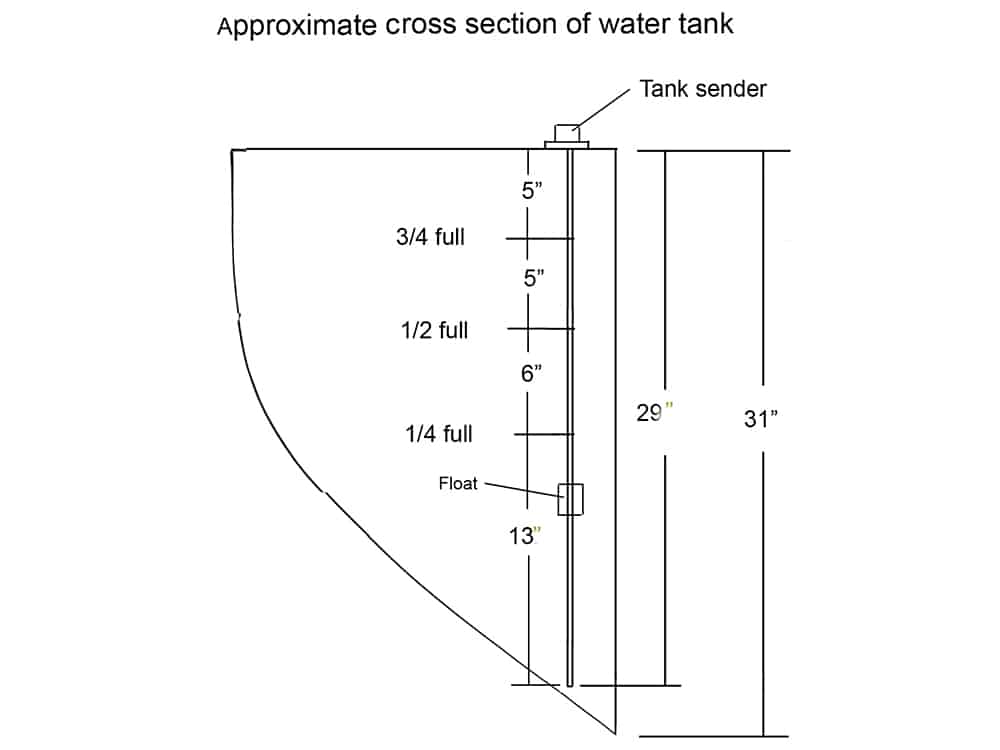
One of the instruments I find most useful on a boat is the gauge that indicates the amount of fresh water in the tanks. If there is one thing you need to know when out cruising, especially if you don’t have a watermaker, it is an accurate indication of how much drinking water you have. Over the six years I have owned my Down East 45 brigantine schooner, Britannia, I have expended endless hours messing about trying to get the twin water-tank gauges to register correctly. Britannia has two stainless-steel water tanks amidships, one on each side. The shape follows the curve of the hull and is therefore somewhat triangular in cross section, tapering to a point at the base. This makes accurate calibration of any type of measuring system difficult because when the water is halfway down the vertical side of the tank, the actual capacity is much less than half full — only about one-third full in my tanks. I considered installing a transparent sighting tube up the outside of the tank, but since my tanks are enclosed by bulkheads on all sides, I couldn’t easily drill a hole in the bottom of them to install plumbing fittings and a clear plastic tube. Even if I had managed to fit a sighting tube in each tank, I still would’ve had to physically mark the tube at various capacity levels. To read it would also have required lifting the floorboards on each side every time.
The original system was pneumatic (air) operated. It was supposed to read the air pressure differential in a thin pipe as the water level in the tanks varied and register on the gauge. Basically, it is a simple concept, having only two components and no electrical circuits. Just the device for a cruising boat, you might think.
But the system never worked properly from the day I bought the boat. The gauge would frequently drop to zero, sometimes immediately after a tank was filled to the top, or sometimes slowly over a few days. The whole thing was erratic and unreliable.
To cut a long, frustrating story short, I never did find out why the system didn’t work properly. Finally, I decided to look for a reliable alternative.
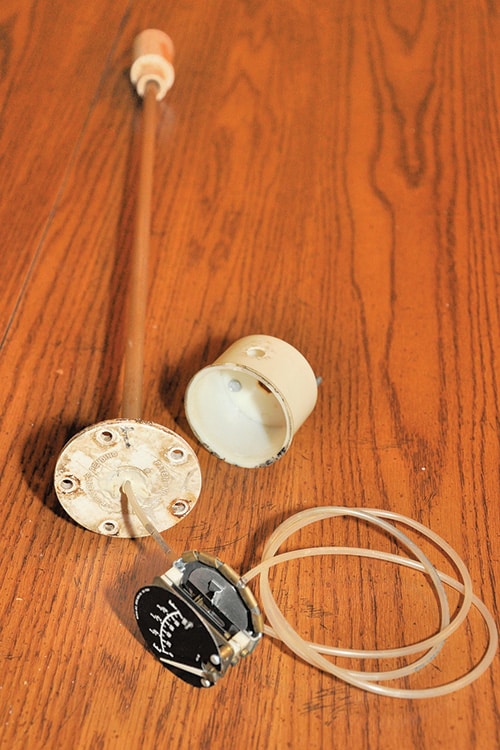
The shape of the tanks meant that a simple electrical swing-arm float sender would not register accurately, because when the arm is halfway on its arc and the gauge registers half full, it will not be correct. There is also a baffle in my tank, which would obstruct a swing-arm system.
There is a product called the Tank Tender that works on the same pneumatic principle as my original equipment. To overcome tank-shape problems, its gauge is calibrated in inches of water. It is for the buyer to determine how many inches corresponds to any particular capacity. The manufacturers told me that most owners mark their gauges with an ink marker at the quarter, half and three-quarters point. This would be accurate, but from my experience, I was concerned about pressure leaks in any air system, and I would have had to have two gauges, one for each tank. The cost for two tanks would be about $570.
There is a product called the Tank Tender that works on the same pneumatic principle as my original equipment. To overcome tank-shape problems, its gauge is calibrated in inches of water. It is for the buyer to determine how many inches corresponds to any particular capacity. The manufacturers told me that most owners mark their gauges with an ink marker at the quarter, half and three-quarters point. This would be accurate, but from my experience, I was concerned about pressure leaks in any air system, and I would have had to have two gauges, one for each tank. The cost for two tanks would be about $570.
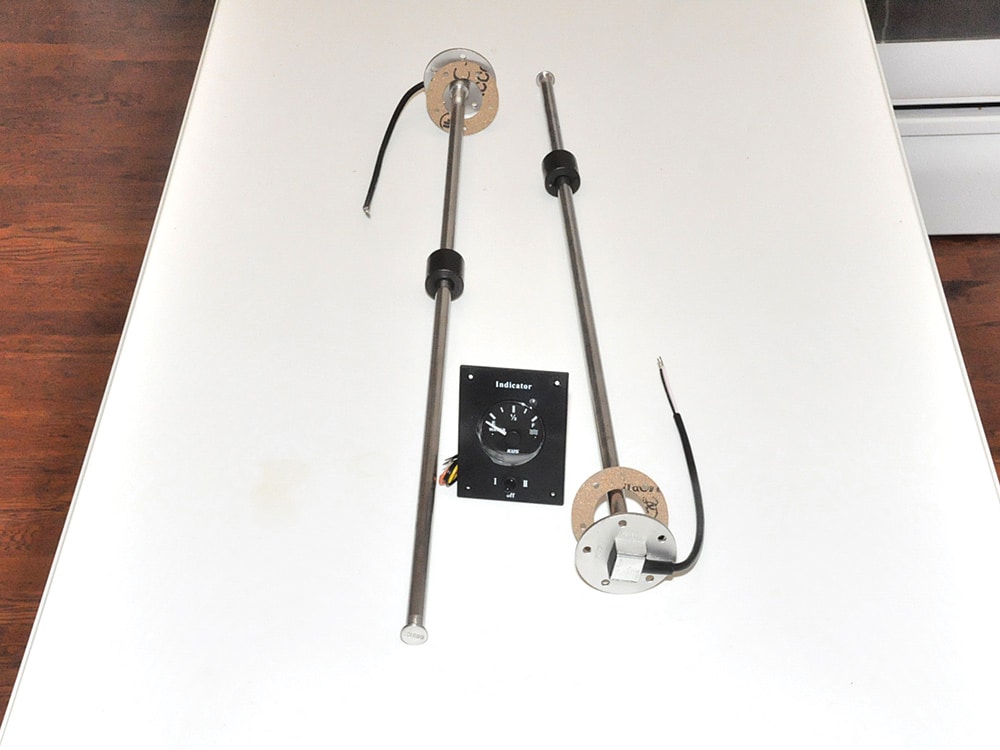
I then found an electrically operated device, made by KUS USA in Fort Lauderdale, Florida. This product also uses a vertical stainless-steel tube inside the tanks, but instead of working on air pressure it has a float that travels up and down the tube, activating electrical signals inside the tube, which are read by the gauge. The sender tube’s top flange fitting also matched the standard SAE five-hole pattern in the top of my tanks, so I would not have to drill and tap any new mounting holes — or so I thought.
The KUS technical department was extremely helpful and told me they could actually custom calibrate the tank-tube senders to my exact tank shape. All they needed was a drawing showing where the various levels were in the tank. This would ensure the gauge would read the correct volume of water in the tank, not just the level, throughout the whole range.
KUS also offers a dual gauge, mounted on a panel, with a switch to read either port or starboard tank. For this gauge to register accurately for twin tanks, both sides have to be the same shape, which mine are.
The first test I needed to do was to find out exactly how much water the tanks held. I drained both sides by running all the water out through the boat’s faucets, then refilled them one at a time using a flow meter fitted to the water hose. The actual capacity turned out to be 168 gallons on each side — eight more than the maker’s specification. This gave a total capacity of 336 gallons.
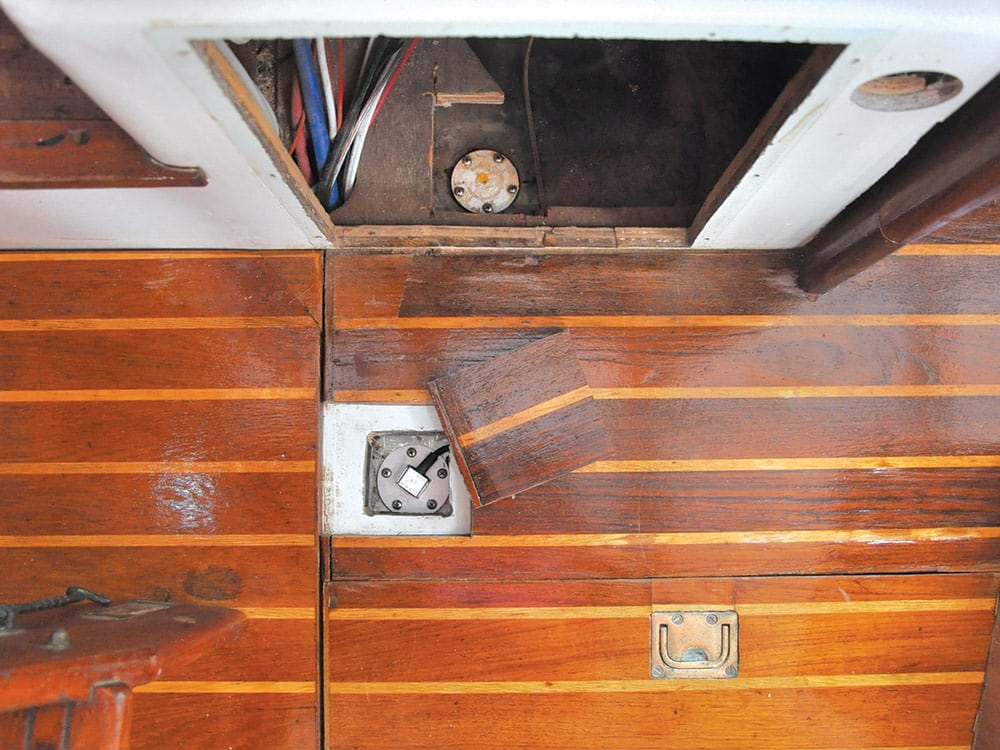
To find out exactly how long the new tank sender pipes needed to be, I measured the depth of the tanks with a ¼-inch-diameter wooden dowel. It was 31 inches to the bottom of the tanks. The sender tube would not fit to the bottom of the tank because of the curvature, however, so I settled for 29 inches. This was when I realized the original 21-inch-long tubes could never have registered accurately anyway, even when they presumably worked properly, because they were 8 inches too short, and never reached anywhere near the bottom of the tank. Calculating this produced an error of about 25 gallons on each side.
Having determined the capacity, I drained the tanks once more and took the opportunity to flush them with two gallons of swimming pool chlorination liquid from a local pool-supply shop. I then ran 42 gallons into the tanks, this being one-quarter of the total capacity, then physically measured the water level with my wooden dipstick. Then I added another 42 gallons and measured where half-full actually was, then another 42 to bring the capacity to three-quarters. I put these dimensions on my drawing, which I emailed to the KUS engineer. I received my kit in two weeks.
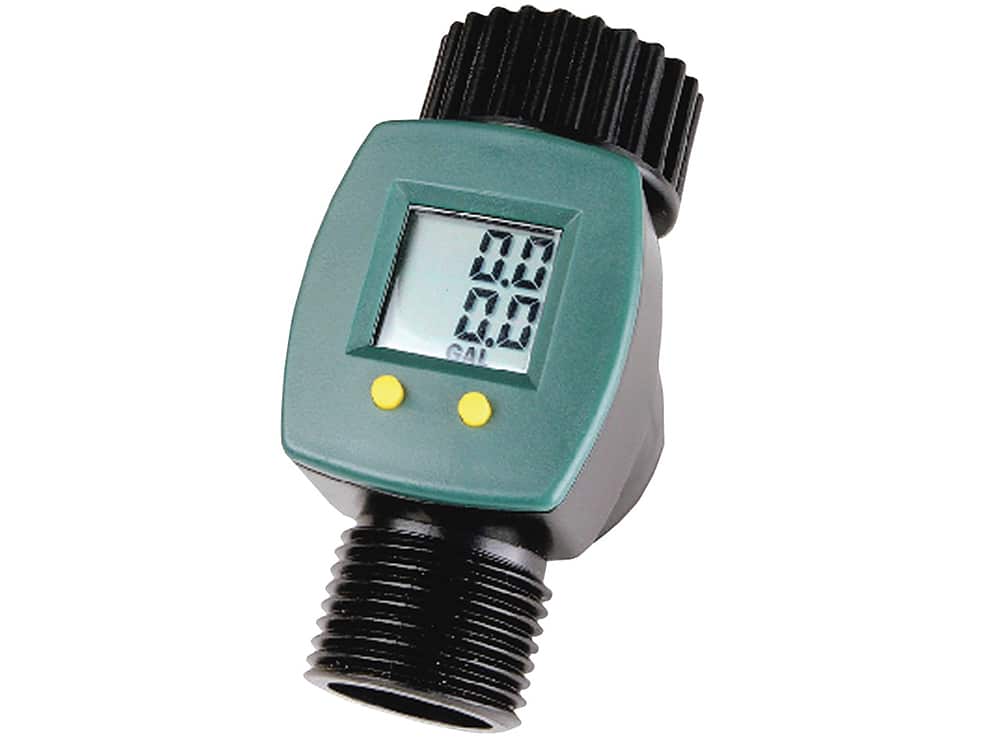
Installing the New System
I drained the tanks once more, then lowered the starboard-side tank sender tube through the hole in the top of the tank.
This was when I discovered that the standard SAE (Society of Automotive Engineers) five-hole plate does not have symmetrical holes around the top of the plate, even though it looks like they are equally spaced. There is, in fact, only one position in which the plate can be fitted, and to find this I had to rotate the plate and gasket until the holes all lined up with the screw holes in the tank. I kept losing the location of the gasket and plate until I actually glued the gasket to the top of the tank, then rotated the plate to mate with the holes in the top of the tank.
The actual electric gauge was much easier to fit, but mounting it did require more than the regular round hole. It’s more like a square hole, which I made by making a template out of paper and sticking it in place with Scotch tape, then I drilled the corners and cut between them with a keyhole saw. The wiring was easy enough, and I wired the positive wire through a spare breaker on the master panel.
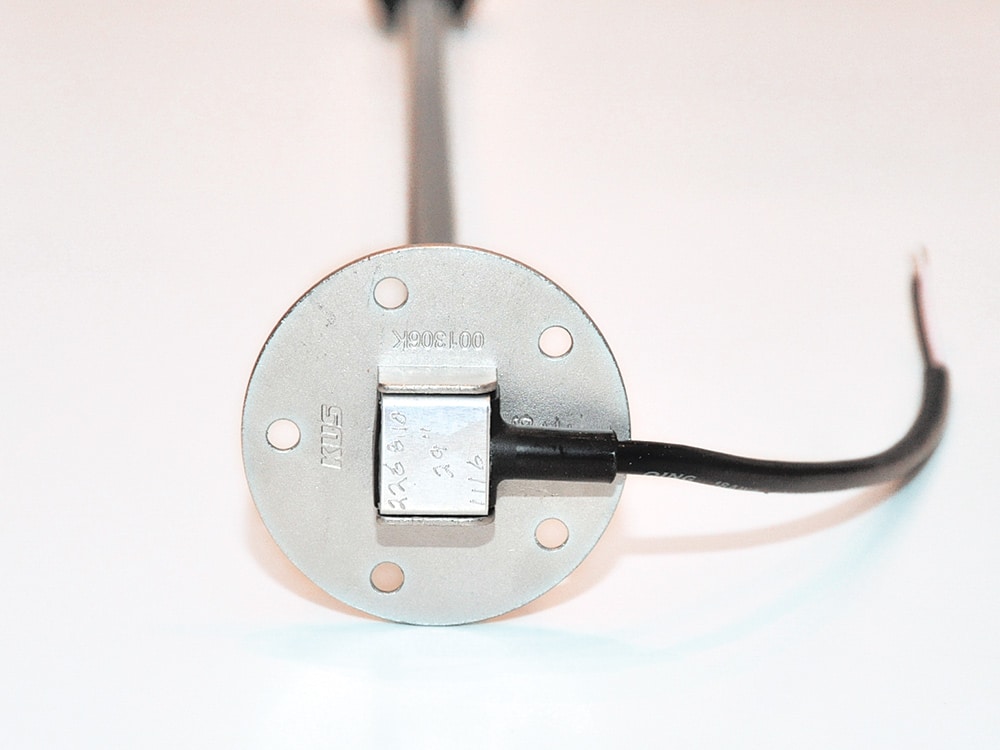
It was then just a matter of refilling the tanks in one-quarter increments, using my new flow meter and checking that the gauge registered correctly, which it did, right through to completely full on both tanks.
Of course, the reading from any tank system, including even a simple sighting tube, will be slightly incorrect when the boat is under sail and heeled.
The total cost for two sender tubes and the dual gauge panel was $320. But if you are content to mark the face of the gauge as you fill the tanks, you could just buy a standard system with your appropriate tube lengths (sold in 1-inch increments). The price would then be less than my custom-calibrated model.
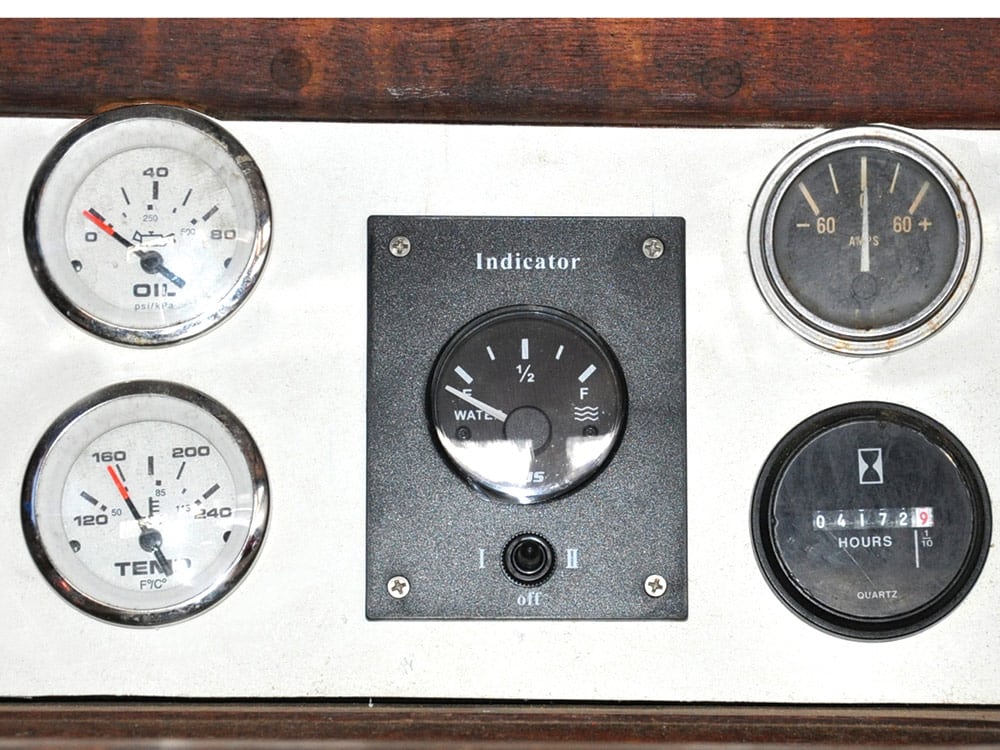
Incidentally, KUS also makes a similar system for fuel tanks, because the same capacity problem exists when diesel tanks are built to the shape of the hull.
It’s now a great relief to know I have a reliable record of water capacity for each tank. This enables us to maximize and enjoy the usage, according to whatever length of passage we are making.








